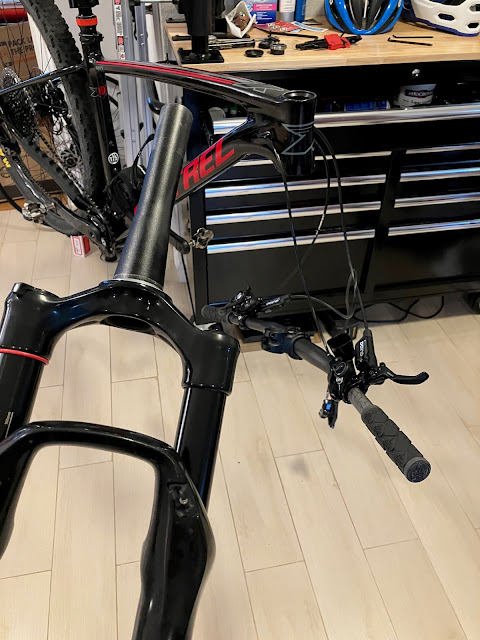So one of the few components I didn't upgrade on BlackBirb, during my recent reconstruction thereof, is the fork. It was doing fine, despite years of almost complete neglect, and so I saw little reason to mess with it.
However, those years of neglect were not without consequence, and on my most recent post-rebuild rides, I did start to notice that the suspension action was not quite as buttery smooth as I remembered it once being, so many years ago.
So, a fork service was in order. Now there's two kinds of fork services: a simple "lower service" where the fork lowers are removed, cleaned, lubricated and reinstalled, and a more invasive full service where the air spring and damper are removed for more invasive treatment, and various seals and o-rings are replaced.
Luckily my fork showed no signs of needing the latter. Specifically, its damping performance seemed as tight as ever, and the air spring did not have any issues with leaking down. Thus, the much simpler lower service would be all that was needed.
First things first, we need to get the victim into the OR.
And then it's off with its head!
Cruel and brutal, perhaps, but necessary for the greater good.
Lucky for us, a bike stand makes a great vice for working on a fork, so with the lifeless body cast aside, we can proceed with the operation.
With a few twists of a 5mm hex bit, a few taps with a hammer to loosen up the damper and airspring shafts, and a firm tug downward, we see the fork spilling its precious life blood.
Hmm, there's something missing here.
Yes, the precious life blood. That would be what's missing.
Well, good thing we're doing the service. On with the show!
These foam rings sit right below the wipers in the fork lowers, and are designed to hold onto some fork oil so that it lubricates the upper fork legs as they slide past. These are not supposed to be black. So, as the instructions instruct, we clean them.
They say perfect is the enemy of good, and I declare this to be good. Good enough.
Now I just need to saturate them in fork oil again, only there's one minor problem: I do not have fork oil. Not yet, at least.
There's two options for buying the required fork oil. For around $18 you can buy a little bottle containing 150ml of the precious fluid. Since each lower service requires just a little over 10ml, and with an optimistic yearly maintenance schedule, this means that this meagre investment would yield a solid 14 years' supply. But then, for $28, you can buy a whole liter of it, which is much, much cheaper per ml, but is simply an absurd quantity for a home-shop tinkerer to ever go through.
Thus, I made the logical, sensible choice.
Well, never gonna run out of that.
Anyway, the foam rings go for a swim.
And then we do our level best to cram them back into the lowers without getting them all folded up and twisted, a task which is a little easier said than done.
Now before we go reassembling the lowers back onto the uppers, we have one more lubrication task at hand: We need to smear some SRAM Butter inside these wiper seals. SRAM Butter is a light grease which sells for approximately $18 for a 1oz tub. Of course the exact same lubricant is available as Slick Honey for $23 for a 2oz tube. I bet you know where this is going. That's right: I bought Slickoleum, also the exact same product, netting me 15oz of the stuff for $25.
Luckily Slickoleum has uses outside of just doing a yearly fork service, so I'll have no problem using it up... eventually. (I actually bought it ages ago and have been using it for general greasing purposes for a while now).
Anyway, the important thing to note here is that, while usually a thin coating of grease is all that's required, since any excess will tend to just get smeared away and collect dirt and generally be a nuisance, in this case an ample application is actually appropriate. The inside of the wiper seals is actually concave, and the space it forms there can hold onto an awful lot of grease. So, go ham with it.
Right, so with that done, we're on to the second hardest part of the fork lower service: getting the lowers back on the fork. This takes a bit of struggling and a bit of cursing, as the wiper seals are slightly smaller than the upper stanchions (for obvious reasons). Luckily the seals on my fork were still quite soft and supple (not to mention incredibly well lubricated), and thus only took a moderate amount of struggling and swearing before things were back in place.
Finally we can give the fork its injection of life blood, 5ml of it in each leg.
And this is also the reason why a bike repair stand makes an ideal vice for doing a fork service.
Because in any other orientation, this fork oil would just end up on the floor.
So with the oil in and the bolts buttoned up and twerked to factory spec, there's only one thing left to do.
We need to get the bike back together again. And try to remember which way the cables were tangled up so they don't get all twisted and weird when the handlebars go back in place.
And there we go. It is, once again, An Bike. It rides like a dream; the fork soaking up the tiniest bumps with ease, with not even the slightest sign of stickiness to be found.
















No comments:
Post a Comment